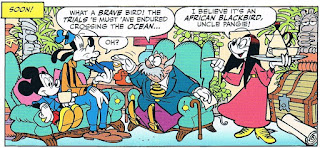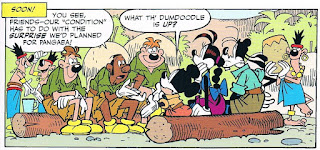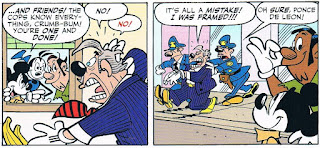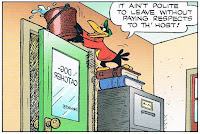However, he did draw the cover:
With the ducks, especially with Scrooge’s treasure-hunting inclinations, there’s usually a logical reason related to the innate nature of their character(s) that they wind up on the adventures that they do. Even with Donald’s everyman nature, the plot m.o. can be his drive to prove himself. That’s not to say that even Barks didn’t contrive reasons why Donald and the nephews, sans Scrooge, would find themselves in life-threatening predicaments on the other side of the world. But it’s really Mickey, not Donald, with whom more than once, I’ve stopped and wondered, “Hey, just HOW has he had all those adventures, anyway?” (In the stories in which he’s not acting in his quasi-established role of a private investigator. Actually, I’m not even sure if he considers himself one, or if he just is always helping Chief O’Hara out as a friend.)
The real hero of “The Lost Explorers’ Trail” is Eurasia Toft. By all rights, it’s her story: it’s the pride, passion, and skill with which she takes up being the heir to her father’s legacy that drive the narrative. Mickey and Goofy are just along for the ride. Casty tacitly acknowledges this fact with M&G's very reason for accompanying Eurasia (they want to see how things turn out, as if they’re the reader), and how they become privy to the situation in the first place: a letter meant for Professor Toft is mistakenly delivered to Mickey’s address. It’s to Casty’s credit that I didn’t really notice this the first time through. Their enthusiasm for and earnest curiosity for the mission sells this case of tentative plot logic, which is then reinforced proactive initiative Mickey and Goofy take in a least getting through the adventure, even if they don't really have an impact on much of what happens. More often than not, Eurasia takes the lead...
...but Mickey and Goofy prove worthy partners in her adventure, weathering its perils just as well:
Arguably, Goofy is more extraneous than Mickey, but the opening “pancake contest” scene establishes a joined-at-the-hip “bosom buddies” camaraderie that continues to be exhibited throughout the story, distinguishing it from all those stories where Goofy is pretty much just there. I like Casty’s take on him here: while he’s aware of what’s going on and as and fully engaged as Mickey. See how they're equally at rapt attention here:
Or how Goof correctly notices something important BEFORE Mickey does:
But of course, when someone screws up, it's inevitably going to be Goofy... innocently enough:
I’m not sure what to make of Eurasia, really. My knee-jerk reaction is that I’m not too keen on the employment the “nebbish librarian type who takes off her glasses and is suddenly an ass-kicking hot chick” cliché. (I’m taking it that her mom was a mouse, as her dad isn’t? Hey, I guess what proves that she’s a major character is that she has a Mickey/Minnie-style head, despite her taller height and creepy humanoid body.) In fact, all of the incidental characters in her orbit and the “part” each plays feel very familiar. There's her “jolly”, affable, intellectual, accomplished, now retired father, Pangea, who because of his pure, boundless love for his field, cannot truly forget the mystery he left unsolved and his missing friends. But he has great pride in his daughter, the bona fide apple-of-his-eye, and sees in her hope to finish what he couldn't. Then there's Pangea's equally spirited and insatiably curious adventure chums of academia. And finally, there's their corrupt, backstabbing, deceitful former peer. Even the way the secret valley’s biggest secret turns out to be able to cure Pangea's rheumatism, actually. I’m not saying this familiarity is a bad thing – I’m just observing it. It’s worth noting, though, that when I lay all that out, it becomes apparent that this is more of a Eurasia Toft story than a Mickey Mouse story, eh?
...look, they even KNOW it!
Regardless, it IS a Mickey Mouse story in that it was intended and produced as one, and, hey, having adventures is what Mickey does in comics, so the writers have to come up with reasons for him to have new ones, right? As archetypal as the new and/or incidental characters might be, Casty defines them with acute clarity and tells their story with airtight plotting. It struck me as unusually, almost realistically dark for a Disney comic how insidious the villain actually is, in having appeared to be an upstanding citizen but having actually left his friends for dead decades earlier. As fatal as most Disney comic villains’ intentions might be, the effects of their ill actions are usually attempted and thwarted in a linear span of time contained within one story.
As reflected in (in addition to the almost trans-Mickey plot and trans-Mickey cast) Cavazzano’s (literally) edgy, feisty, "zinging" art and the modern slang used by dialogue scribe Jonathan Gray, this is neither Gottfredson’s nor Murry’s Mickey, no. Nonetheless, it IS a modern incarnation of and in the Mickey Mouse adventure comic tradition that doesn’t betray the character or the genre. And that should be commended and celebrated.
_______________
And for those inclined, the Mickey Mouse comics tradition can be celebrated with this issue’s backup features: a quintessential Don Christensen-Paul Murry 1953 Pluto story (replete with narrative/commentary captions) and two Bill Walsh-Manuel Gonzalez Mickey Mouse Sundays featuring Ellsworth, including his very first appearance. I’ve written before of how from my limited exposure to the character, I wasn’t sure who or what he was ever even intended to be. But now, at last, I know Ellsworth for the smart-aleck prankster that he is. Kudos on your editorial choices, Mr. Gerstein. Ellsworth is now squarely established for further IDW appearances.
-- Ryan











"Ellsworth is now squarely established for further IDW appearances..."
ReplyDeleteAnd he's going to get them! Wait for it—there's a special reason we're building Ellsworth up, though it'll be next year before all becomes clear.
To be fair the main reason that this is more of a "Eurasia Toft" story than a mouse tale was as part of a personal incentive by Casty to have more strong willed female characters. I'm looking forward to seeing how Casty handles her in MM#4.
ReplyDeleteCasty indeed started purely as a writer, it took a while until he started drawing some of his stories himself. He stil works with other artists for things such as the Darkenblot series...
ReplyDeleteJuliah H -- He's a very good artist himself, and when he works with others, he seems to bring out their best. -- Ryan
ReplyDelete